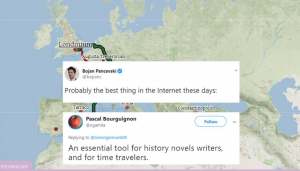 In 2017, researchers off the Bulgarian coast discovered the oldest intact shipwreck ever found! This ancient Greek vessel was not only nearly 2,500 years old, but was just one of 65 shipwrecks found at the bottom of the Black Sea in remarkable condition. So, why does the Black Sea contain so many well-preserved shipwrecks? Helen Farr and Jon Adams dive into the depths of the unique body of water.
In 2017, researchers off the Bulgarian coast discovered the oldest intact shipwreck ever found! This ancient Greek vessel was not only nearly 2,500 years old, but was just one of 65 shipwrecks found at the bottom of the Black Sea in remarkable condition. So, why does the Black Sea contain so many well-preserved shipwrecks? Helen Farr and Jon Adams dive into the depths of the unique body of water.
Spark your thinking!
1. Set up your social studies mini spark recording page: #47: Ancient Shipwreck.
2. Watch the video. Record details about the Black Sea as you watch. Find the Black Sea on a map and describe its location.
3. Make a study guide for this video on your recording page. Include the answers to at least 5 of these questions. Remind your teacher that the key can be found in the social studies mini spark folder.
- Describe the condition of the shipwreck that was found. What features remained intact?
- How did researchers determine the age of the shipwreck?
- Why is the Black Sea referred to as “the world’s biggest pickle jar”?
- What role did the Black Sea play in historical trade and conflicts?
- Explain the significance of anaerobic bacteria in the preservation of the shipwrecks.
- What challenges do researchers face when attempting to recover artifacts from the shipwrecks?
- Discuss the importance of the discovery of the medieval Italian merchant ship. What does it tell us about trade during that time?
4. Share your social studies mini spark recording page with your teacher/EY coordinator.
 Have you ever thought about the journey a raindrop takes? This mini spark shows you that path through the United States that a raindrop will follow to get to the sea.
Have you ever thought about the journey a raindrop takes? This mini spark shows you that path through the United States that a raindrop will follow to get to the sea. Choose a location to drop your raindrop, look at the data in the top right corner, and record all of the waterways and the distances on your recording sheet.
Choose a location to drop your raindrop, look at the data in the top right corner, and record all of the waterways and the distances on your recording sheet.




 Source:
Source: 

 Revisit the extraordinary life story of Harriet Tubman – a freedom seeker, conductor on the Underground Railroad, abolitionist, suffragist, and human rights activist. Tubman was born around 1822 Maryland. She is widely celebrated as one of the most respected individuals in American history.
Revisit the extraordinary life story of Harriet Tubman – a freedom seeker, conductor on the Underground Railroad, abolitionist, suffragist, and human rights activist. Tubman was born around 1822 Maryland. She is widely celebrated as one of the most respected individuals in American history.








